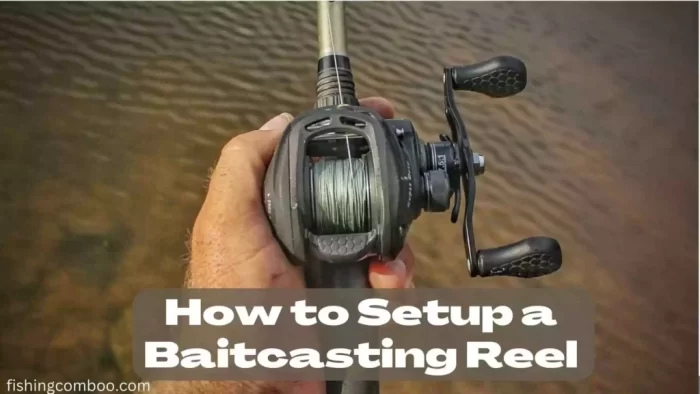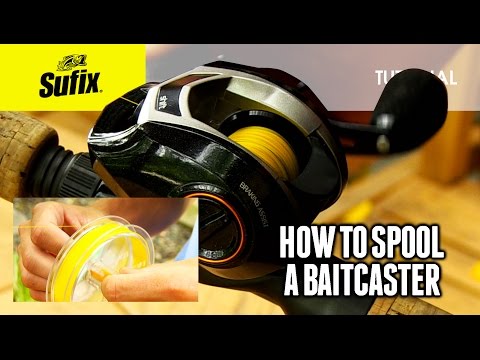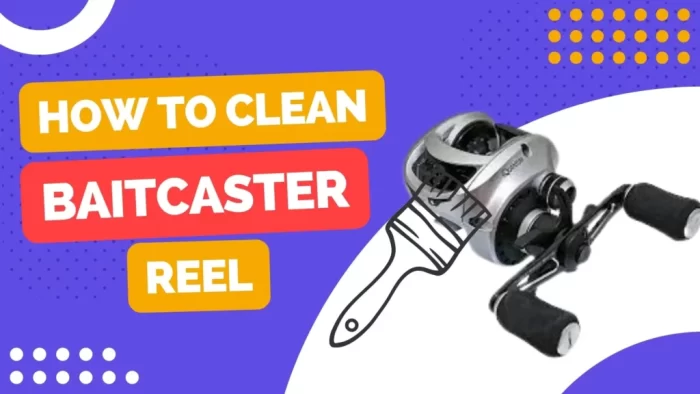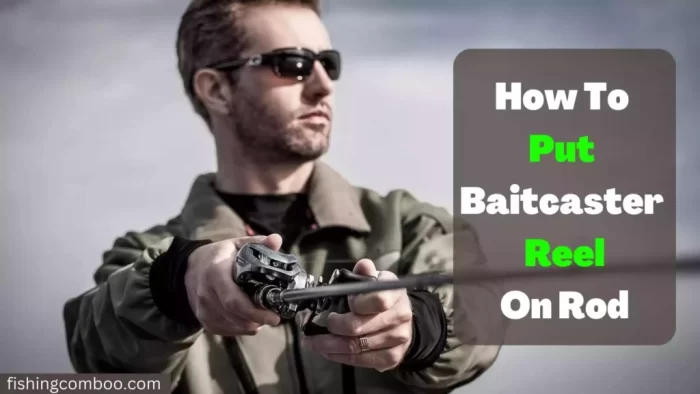
Fishing is one of life’s greatest thrills. The challenge of getting a big fish to bite is always exciting for an angler, whether they’re beginners or professionals. Baitcasting reels can be tricky to set up correctly. If you’re using a baitcasting reel, setting it up correctly is essential for maximizing your chances of success.
As all of the big-time anglers uses baitcasting reels, you might be wondering how to set up a baitcasting reel like the pros. If you practice and have patience, you’ll be casting like a pro in no time.
I’ll walk you through setting up your baitcasting reel step-by-step so you can get started fishing as soon as possible.
The Essentials of Baitcasting
Baitcasting is a method of fishing using bait. Fishing reels are attached to the rod’s handle, near the top. A thumb-operated release casts the line out from a revolving spool. Baitcasting reels are also known as “castor” or “level wind” reels.
Read More About: How to Put a Baitcaster Reel on a Rod
Baitcaster reels are most commonly used for lure fishing, as they allow for more accurate casting and provide more control over the lure. They can be used for live bait fishing, but this is less common as baitcasting reels are more difficult to use than other types of reels and can be more prone to tangles.
WHY USE A BAITCASTING REEL?

Baitcasting reels offer several advantages over other types of fishing reels. These consist of:
Greater Accuracy – The precise placement of your lure is made possible by baitcasting reels. This is especially useful when fishing in tight spots or around cover.
More control – With a baitcaster, you have more control over the lure and can fish at various depths and speeds. Their excellent performance in deep water and currents makes them ideal for fishing.
Increased casting distance – Baitcasting reels allow you to cast your line further than other types of reels. The reason for this is that baitcasting reels have a larger spool, which stores more lines.
Improved drag – Baitcasting reels usually have a better drag system than other types of reels. This is because baitcasting reels are designed for fishing with heavier lures and lines.
Read About: Best Baitcasting Combos
HOW TO SET UP A BAITCASTING REEL STEP-BY-STEP GUIDE
table of contents
Step 1 – Insert Line into the Spool

In order to begin, you need to insert your line into the spool. Start by feeding the line through the guide on the bottom of the reel. Then, continue feeding the line around the spool until it’s fully wound. Be sure to leave enough line hanging off the end so that you can easily attach a lure or hook.
Step 2 – Attach the Lure or Hook
Once the line is in place, it’s time to attach your lure or hook. To do this, simply tie the line to the eyelet on the lure or hook. To prevent the knot from unravelling when you’re casting, make sure it is tight.
Step 3 – Fill the Spool with Line
How To Line A Baitcaster
Spooling your fishing line on is the third step. When you’re spooling on your line, it’s important to use a guide. People often make the mistake of not using a guide and end up with a tangled mess. The guide will help keep your line from twisting and tangling as you spool it on.
Next, connect the other end of your fishing line to the spool. To do this, use a figure-eight knot. As you’re casting, this will keep the line from slipping off the spool.
If you load the line excessively, it will result in backlash. Please don’t overfill the spool with line.
Step 4 – Adjust Spool Tension
As a baitcasting reel uses a spinning spool, the key to successful casting is getting the spool tension set correctly. If the spool tension is too light, your line will come off the spool too easily, and you’ll end up with a tangled mess.
If the spool tension is too tight, your lure won’t be able to travel far enough on the cast, and you’ll end up frustrated. Finding the happy medium is essential for successful baitcasting.
Ways to Set Spool Tension
There’re multiple methods for adjusting the spool tension on a baitcasting reel. Most baitcasting reels will have some sort of knob or lever that can be used to adjust the tension. The tension can also be adjusted with a clicker that comes with some models.
Once you’ve found the tension adjustment knob or lever, it’s time to start experimenting. Start with the tension set fairly light and make a few practice casts. If your line is coming off the spool too easily, tighten the tension a bit and try again. You can loosen the tension if the lure isn’t going very far on the cast. It’s a good idea to make a few practice casts with different tension settings until you find the sweet spot.
In general, it is preferable to err on the side of excess tension rather than deficiency. It’s easier to loosen the tension if needed than to try to fix a tangled mess. Once you’ve found the perfect tension setting, make a few practice casts to ensure everything is working correctly.
If you’re facing too many bird’s nest or backlashes while setting the spool tension, just read my detailed guide on how to cast baitcaster without backlash.
Step 5 – Adjust the Braking System
The braking system on a baitcasting reel prevents the spool from spinning too fast, causing a bird’s nest. To adjust the brake, start by turning the knob at the front of the reel clockwise. This will increase the amount of braking power. If you find that the spool is still spinning too fast, try turning the knob a little further clockwise.
If you’re having trouble casting without getting a bird’s nest, try decreasing the amount of brake power. To do this, turn the knob counterclockwise at the front of the reel. Once you’ve found the perfect setting, lock the knob in place.
Check Out Best Overall Baitcasting Reel
Types of Braking Systems
The two most common types of braking systems are centrifugal and magnetic.
Magnetic Braking System: Daiwa
Magnetic braking systems use magnets to create resistance and slow down the spool. The amount of braking power can be adjusted by moving the magnets closer to or further away from the spool.
To adjust the brake on a reel with a magnetic braking system, start by turning the knob at the front of the reel clockwise. This will increase the amount of braking power by bringing the magnets closer to the spool.
If you find that the spool is still spinning too fast, try turning the knob a little further clockwise. Once you’ve found the sweet spot, lock the knob in place so it doesn’t get accidentally turned.
If you’re having trouble casting without getting a bird’s nest, try decreasing the amount of brake power. To do this, turn the knob counterclockwise at the front of the reel. This will move the magnets away from the spool and decrease the amount of braking power.
Once you’ve found the perfect setting, lock the knob in place.
Centrifugal Braking System: Shimano
Centrifugal braking systems use centrifugal force to create resistance and slow down the spool. You can alter the braking power by shifting the brake blocks around.
When centrifugal force is applied to a spinning object, it will cause the object to slow down. The same idea can be applied to make a brake for a baitcaster. By adding weights to the outer edge of the spool, you can increase the centrifugal force and slow the spool’s rotation.
This is an effective way to prevent backlashes and line tangles. To set the centrifugal braking system on a baitcaster, start by loosening the side plate screws. Then, remove the side plate and add weights to the desired location on the spool.
Once the weights are in place, replace the side plate and screw it back into place. You can experiment with different numbers and locations of weights to find the perfect setting for your fishing conditions. Your casting skills will improve rapidly with just a little bit of practice.
Step 6 – Configure the Drag
An essential component of a baitcaster is the drag system. A baitcasting reel’s drag plays a crucial role. When a fish strikes, the drag system controls how much line is to release. If the drag is too loose, the fish can take out more lines than necessary, making it difficult to land the fish. On the other hand, if the drag is too tight, it will be difficult to reel in the fish. As a result, it is important to find a happy medium when setting the drag on your bait caster.
There’re several methods for adjusting the drag on a baitcaster. The first method is to use your thumb to apply pressure to the spool while casting. This will help you to get a feel for how much pressure you need to apply to achieve the desired results.
Second, you can use a weight scale. Simply attach a weight scale to your line and cast it out. Once you have a fish on the line, slowly reel in the slack until the weight scale registers the desired drag setting.
Thirdly, you can use a piece of paper. Take a piece of paper about the same width as your spool and cut it into a strip. Next, attach the strip of paper to your line and cast it out. Once you have a fish on the line, slowly reel in the slack until the paper strip is pulled from the spool.
Finding the right drag setting is essential, no matter which method you opt for. Once you have found a setting that you are happy with, be sure to write it down so that you can replicate it in the future.
Step 7 – Set the Reel’s Gear Ratio
The gear ratio on a baitcasting reel is important because it determines how fast the line will be reeled in. A higher gear ratio means the line will be reeled in faster, while a lower gear ratio means the line will be reeled in slower. For most fishing conditions, a gear ratio of 6:1 is ideal.
A baitcaster reel’s gear ratio indicates how many rotations the spool will undergo with each turn of the handle. A higher gear ratio results in more rapid spool rotation, while a lower gear ratio yields slower spool rotation. It is important to consider the type of fishing you will be doing most often when choosing the right gear ratio for your reel.
For example, if you plan to fish for smallmouth bass in fast-moving water, you will want to choose a high gear ratio reel to retrieve your lure quickly. However, if you are fishing for largemouth bass in slower-moving water, you will want to choose a lower gear ratio reel to control your lure better.
Ultimately, the best way to determine what gear ratio is right for you is to experiment with different settings until you find the one that works best for your particular fishing situation.
Step 8 – Cast Out and Enjoy!

Now that your reel is set up, it’s time to cast out and enjoy the fruits of your labor. You can quickly become an expert at baitcasting with a little practice. Who knows, you might even end up hooked on fishing for life!
Final Thoughts
As a beginner, understanding how to set up your baitcasting reel is essential for having a successful and enjoyable fishing experience. You’ll be well on your way to fishing like a pro in no time if you follow the instructions provided in this article. So, what are you waiting for? Get out there and start casting!





